You are seeing this message because you are using an out-of-date browser.
Please click here for more information.
The Saturn's Family of Moons
If you were to take a family portrait of Saturn's moons, you might be tempted
to say that it didn't looke like they were related at all. The moons vary widely
is both size and appearance, which might make you look at the family portait and
wonder if they were even distantly related.
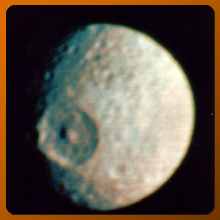
Image courtesy of: Voyager mission
One of Saturn's more interesting moons also appears to be one of its luckiest. The small, only a little over 240 miles in diameter, moon Mimas was the victim of an impact that almost smashed the tiny moon into pieces. The large crater on one end of the moon is almost one-third the size of the entire moon. How did the moon survive such a huge impact without breaking into pieces? There are cracks in the surface of Mimas on the side opposite from the crater that are probably the result of the same impact that caused the large crater.
In addition, scientists also believe that there were earlier impacts that did break the moon into pieces, but over time gravity reassembled the pieces into the moon we see now. Mimas is very lucky indeed to still be in one piece.
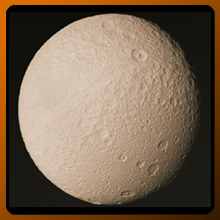
Image courtesy of: Voyager mission
Several of Saturn's moons are made up mostly of water ice and Tethys is one of those moons. The light brown surface of this moon is, relatively speaking, very smooth, tells us that at some time in the distant past the moon probably wasn't frozen solid like it is now.
If you look closely at the picture at right, you can see that while there are many craters on the moon's surface, there aren't nearly as many as there are on other moons in the solar system, including our own Moon. This is one of the clues that have made scientists believe that Tethys has not always been frozen solid.
Tethys is the ninth in the family of Saturnian moons and is a little over six hundred fifty miles in diameter. It orbits Saturn at a distance of a little over 180,000 miles.
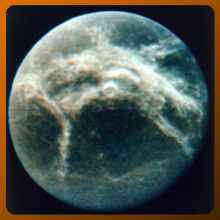
Image courtesy of: Voyager mission
Dione is another example of how there is no substitute for actually visiting somewhere to see what things are really like. Although the moon Dione was discovered in 1684, all we were able to see from here on Earth was a very tiny speck of light that orbited Saturn. After all, the moon is just over 660 miles in diamater and even a very large telescope can't see any detail in something that small from such a large distance.
Voyager sent back this amazing image of a moon that has a very beautiful pattern of bright diagonal lines crossing one side of the moon. On the other side of the moon, there are lots of craters much like the other moons in the solar system. This is very much a mystery, as you would expect both sides of the moon to have lots of craters. The best guess we have now is that during the period when the craters accumulated, Dione was in an orbit that always had the same side facing outwards, much like our own Moon.
It is another mystery that we may never have a real answer for. The origin of the bright stripes is still another puzzle for us to solve. It could be the result of some kind of eruption along cracks in the surface of the icy moon, but all we have at this point are guesses, and not very good ones at that.
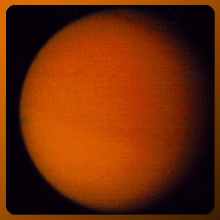
Image courtesy of: Voyager mission
Titan is the largest of Saturn's moons and is one of the largest moons in our solar system. At over 3,000 miles in diameter, it is even larger than the planets Mercury and Pluto. Titan was discovered by the Dutch astronomer Christiaan Huygens in 1655 and has been carefully studied and observed by professional and amateur astronomers ever since. Because of its large size, Titan is easy to see using even a small telescope.
In spite of it's large size and easy visibility, though, Titan remains a very mysterious place to those of us here on Earth because it is covered by a thick layer of clouds that we cannot see through.
Not only is the layer of clouds surrounding Titan impossible to see through, it is very dense. The atmospheric pressure, or the weight of the moon's atmosphere, is one and a half times as much as it is here on Earth.
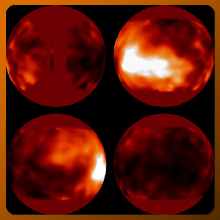
Image courtesy of: Hubble Space Telescope
Although we cannot see through the thick atmosphere of Titan, the Hubble Space Telescope has been able to give us some tantalyzing clues about what lies underneath the thick cloud blanket. The picture at right, taken with Hubble's infrared camera, shows what appears to be a very large "continent" on the moon in the bright areas of the picture. We aren't sure about what the dark areas are, but they could be liquid oceans of some kind. The surface of the moon is much too cold for the oceans to be water, but there is a possibility that some other liquid could exist on the cold moon.
When the Cassini mission arrives at Saturn, it will drop the Huygens probe on to Titan which will, hopefully, answer some of these questions as well as many others that we have about this very large, mysterious moon.
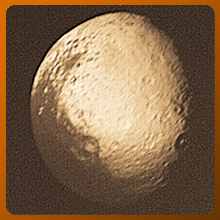
Image courtesy of: Voyager mission
We mentioned at the top of this section that if you were to take a family portrait of the moons of Saturn that you would wonder if the moons were even distantly related and Iapetus is one of the family members that makes this point very clearly.
One side of this moon, which is a little over nine hundred miles in diamater, is very bright while the other side looks as if it has been left outside in an industrial area for a very long time. The brighter part of Iapetus is probably just the ice that the moon is made of. The darker material, though, is quite a mystery. Theories range from dark material that originates from the moon's interior to debris knocked off neighboring moon Pheobe.
None of these theories are completely satisfactory, though, so we will just have to wait for future missions, like the Cassini spacecraft, and hope that they will provide us with some concrete facts.

